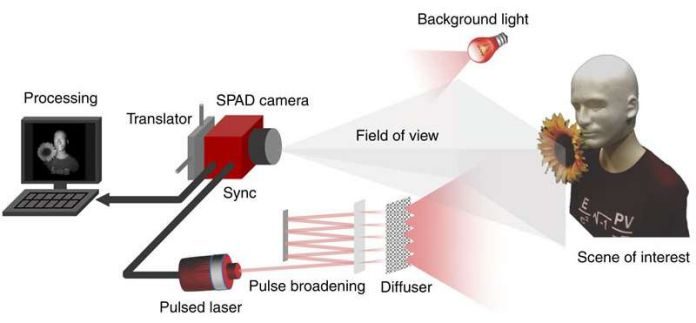All of you know that 3D printing technology increasing day by day in this modern technology era. Previously, in ‘New Approach Makes 3D Printing Technique More Accessible‘ we came to know about new approach has been developed to make 3D printing more accessible.
Similarly, a team of researchers has developed an algorithm to generate high-quality 3D images. This is done by using a single-photon camera that detects only one signal photon per pixel. This new photon-counting camera can be used at much lower fluctuations with more high effectiveness. Generally, whenever we click pictures, our ordinary camera identifies above a billion of photons. For example, a 1-megapixel camera can identify above 1,000 of photons per pixel. But, this new camera can click images with a final resolution of 384 x 384 pixels.
This latest research has been held by Jeffrey Shapiro, a professor of electrical engineering and computer science at the Massachusetts Institute of Technology (MIT), in collaboration with co-authors at MIT, Polytechnics di Milano, and Boston University.
This new scheme consists of highest photon effectiveness to date than other camera-based 3D imaging techniques. And as a result, it develops better precise conversion and essential sequence of better depth resolution.
The researchers illuminated a scene of interest like mannequin and sunflower through a pulsed laser. This pulse laser emits low-light pulses every 50 nanoseconds. They used it for detecting how this new single-photon imaging algorithm works in low-light environments. It can recognize neighboring pixels and also has strong structural correlations, which are divided by sharp boundaries that separate two different features. This algorithm even shows that structural correlations to generate high-resolution 3D images using very few photons after solving a mathematical problem of convex optimization.
As a result: these single photon camera captured the light reflected by the illuminated objects, along with some background light that the researchers added to regenerates a real environment. It can recognize neighboring pixels and also has strong structural correlations, which are divided by sharp boundaries that separate two different features. This algorithm even shows that structural correlations to generate high-resolution 3D images using very few photons after solving a mathematical problem of convex optimization.
The camera consists of single-photon avalanche diode (SPAD) array as an essential element. This can detect arriving photons and even record its arriving time. The out coming image with 384 x 384 pixels resolution has one signal photon and one background light photon are detected per pixel.
The important benefit of this new single-photon camera is that it can capture images very fast. It has useful applications that require fast and accurate imaging using extremely small amounts of light, biological imaging, astronomy, and providing a 3D vision for self-navigating advanced robotic systems.
Scientists are also pushing the technology to its limits under DARPA sponsorship as part of DARPA’s Revolutionary Enhancement of Visibility by Exploiting Active Light-fields (REVEAL) program. REVEAL’s goal is to use all the information available in the light field to see into occluded spaces without using mirrors.
Shapiro explained, “We’re going to use laser light and single-photon detection to see around a corner. Our approach will rely on diffuse reflections from a wall. Because the light returned from the hidden objects will be very weak, photon efficiency is essential.”
